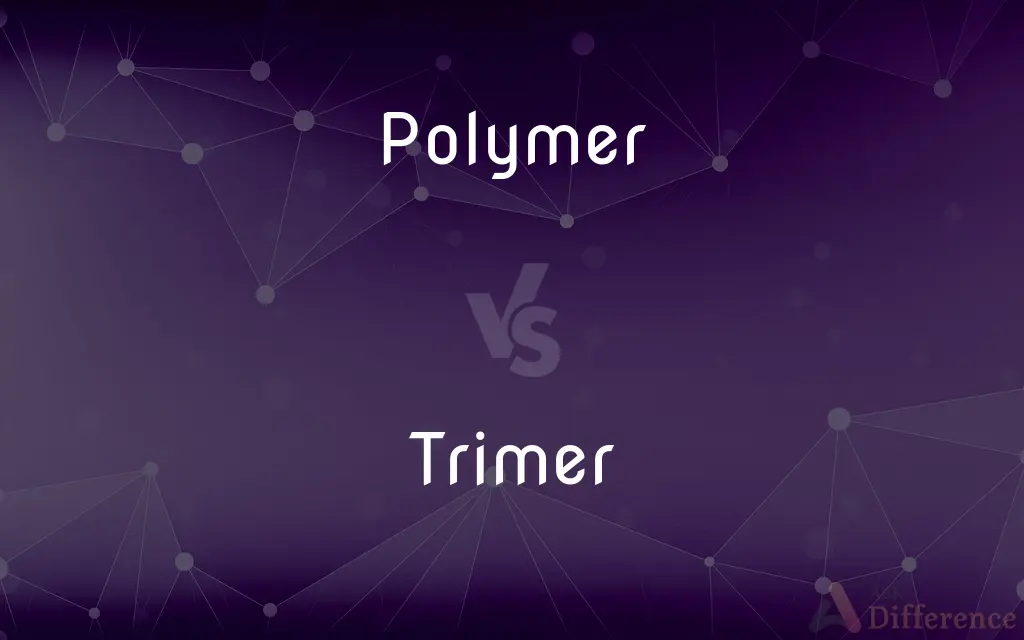Polymer vs. Trimer — What's the Difference?
Edited by Tayyaba Rehman — By Maham Liaqat — Updated on April 17, 2024
Polymer refers to large molecules made of repeating structural units, typically created through polymerization; trimer is a specific type of polymer made up of three identical molecules joined together.

Difference Between Polymer and Trimer
Table of Contents
ADVERTISEMENT
Key Differences
Polymers are substances whose molecules have a high molar mass and are composed of a large number of repeating units. They can be natural, like cellulose, or synthetic, like nylon. While trimers are a specific kind of polymer that consists of just three monomeric units linked together. This makes trimers much simpler in structure compared to many complex polymers.
Polymer chains can vary in length from thousands to millions of repeat units, affecting their physical properties like strength, elasticity, and melting point. On the other hand, trimers, with only three units, often have more predictable and uniform chemical properties and simpler structures.
The production of polymers typically involves chemical reactions that can be initiated by heat, light, or catalysts, leading to a wide variety of materials with diverse applications. Whereas trimer formation is often a specific intermediate or byproduct in the synthesis of more complex polymers and may require careful control to achieve.
In terms of functionality, polymers are versatile materials used in everything from clothing and packaging to auto parts and electronic devices due to their diverse properties. Trimers, while less versatile on their own, are crucial in the study of polymer chemistry and can be used to model or understand more complex polymer behaviors.
Polymers can be designed to be biodegradable, conductive, or resistant to heat and chemicals depending on their composition and structure. Trimer, as a simpler entity, does not typically offer this range but can be important in creating specialized polymers with desired properties by acting as building blocks or intermediates.
ADVERTISEMENT
Comparison Chart
Definition
Large molecules made from repeating units.
Polymer made up of three linked monomeric units.
Complexity
High, with potentially thousands of repeating units.
Low, limited to three repeating units.
Physical Properties
Varies widely (flexible, rigid, durable).
Generally more uniform and predictable.
Applications
Broad (textiles, automotive, healthcare).
More limited, often used in research.
Chemical Synthesis
Involves polymerization through various techniques.
Often formed as intermediates in polymerization.
Compare with Definitions
Polymer
A substance with molecular structure consisting chiefly or entirely of a large number of similar units bonded together.
Nylon, a synthetic polymer, is used extensively in the textile industry.
Trimer
May exhibit unique chemical or physical properties.
Certain trimers are studied for their potential in nanomaterial applications.
Polymer
Bio-polymers occur naturally within organisms.
DNA is a biopolymer essential for genetic information.
Trimer
Useful in research and modeling of polymers.
Trimer studies help understand the behavior of larger polymers.
Polymer
Any of various natural or synthetic compounds of usually high molecular weight.
Starch is a natural polymer made up of glucose units.
Trimer
Often produced as an intermediate in polymer synthesis.
A trimer might be isolated during the production of a more complex polymer.
Polymer
Polymers can be thermoplastic or thermosetting.
PVC, a thermoplastic polymer, is used to make pipes.
Trimer
Not as versatile as larger polymers.
Trimers have limited use compared to broad applications of polymers.
Polymer
Materials made by polymerizing monomers.
Polyethylene is a polymer formed by polymerizing ethylene.
Trimer
A polymer consisting of three identical monomeric units.
Formaldehyde trimer, trioxane, is a cyclic trimer.
Polymer
A polymer (; Greek poly-, "many" + -mer, "part") is a substance or material consisting of very large molecules, or macromolecules, composed of many repeating subunits. Due to their broad spectrum of properties, both synthetic and natural polymers play essential and ubiquitous roles in everyday life.
Trimer
A chemical compound or molecule consisting of three identical simpler molecules.
Polymer
Any of numerous natural and synthetic compounds of usually high molecular weight consisting of up to millions of repeated linked units, each a relatively light and simple molecule.
Trimer
(chemistry) A polymer composed of three monomers
Polymer
(organic chemistry) A long or larger molecule consisting of a chain or network of many repeating units, formed by chemically bonding together many identical or similar small molecules called monomers. A polymer is formed by polymerization, the joining of many monomer molecules.
Trimer
A polymer (or a molecule of a polymer) consisting of three identical monomers
Polymer
A material consisting of such polymer molecules.
Polymer
Any one of two or more substances related to each other by polymerism; specifically, a substance produced from another substance by chemical polymerization.
Polymer
A naturally occurring or synthetic compound consisting of large molecules made up of a linked series of repeated simple monomers
Common Curiosities
How is a trimer related to polymers?
A trimer is a specific type of polymer composed of exactly three monomeric units bonded together.
What are the typical uses of polymers?
Polymers are used in a vast range of products, including clothing, electronics, packaging, and biomedical devices.
How do the properties of polymers and trimers compare?
Polymers vary widely in properties depending on their length and the types of monomers used, whereas trimers, with only three units, usually have more predictable properties.
Can trimers be used in industrial applications?
Trimers are generally more useful in scientific research than in industrial applications, though they can play roles in the synthesis of more complex polymers.
What is a polymer?
A polymer is a large molecule composed of repeating structural units, typically connected by covalent chemical bonds.
What is the significance of biopolymers?
Biopolymers, such as DNA and proteins, are crucial for life functions and are studied extensively in biochemistry and medicine.
Can trimers be naturally occurring?
Yes, some natural substances can act as trimers, though they are less common than larger polymers.
What makes trimers important in polymer chemistry?
Trimers can provide insights into the mechanisms of polymerization and are often used in studies to understand larger polymers.
Why might a chemist focus on producing trimers?
Chemists may produce trimers to study the fundamental properties of polymerization or to create specialized materials.
What role does the number of units in a polymer play in its properties?
Generally, the more units in a polymer, the more varied and complex its properties can be.
What is the difference between thermoplastic and thermosetting polymers?
Thermoplastic polymers can be melted and remolded, whereas thermosetting polymers harden permanently after being shaped.
Are all polymers synthetic?
No, there are many natural polymers, such as cellulose in plants and proteins in animals.
How are polymers synthesized?
Polymers are synthesized through chemical reactions that link monomers into long chains, which can be initiated by catalysts, heat, or light.
Are polymers environmentally friendly?
Some polymers, especially certain synthetics, can be environmentally problematic, but biodegradable polymers are designed to reduce environmental impact.
How are polymers and trimers studied in science?
Scientists study polymers and trimers using techniques like spectroscopy, X-ray crystallography, and electron microscopy to understand their structures and properties.
Share Your Discovery

Previous Comparison
Exercise vs. Exertion
Next Comparison
Bundestag vs. ReichstagAuthor Spotlight
Written by
Maham LiaqatEdited by
Tayyaba RehmanTayyaba Rehman is a distinguished writer, currently serving as a primary contributor to askdifference.com. As a researcher in semantics and etymology, Tayyaba's passion for the complexity of languages and their distinctions has found a perfect home on the platform. Tayyaba delves into the intricacies of language, distinguishing between commonly confused words and phrases, thereby providing clarity for readers worldwide.
















































